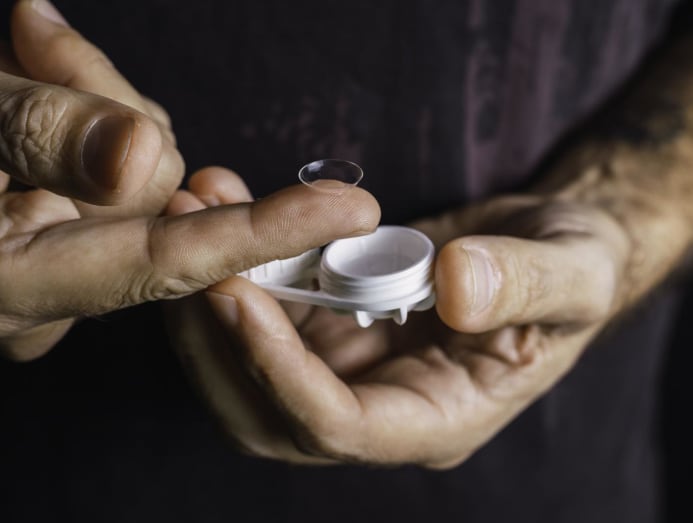What are multifocal contact lenses and how do they correct presbyopia?
Multifocal contact lenses may be an alternative for those grappling with myopia and presbyopia in their 40s – and aren't so keen to completely rely on glasses with progressive lenses.
In partnership with Johnson & Johnson.

(Photo: iStock/Mr Korn Flakes)

This audio is generated by an AI tool.
You know you have presbyopia when your regular glasses or contact lenses only appear to work when you hold things at arm’s length. Or you may need to use the light on your handphone to read the menu, or increase the font size on your devices. Lifting your glasses to decipher fine print is another giveaway.
Welcome to your 40s, when you get a little grey, a little creaky and your eyesight, well, a little blurrier than usual. And it’s not just from the myopia that many Singaporeans have been grappling with since childhood. (We are the myopia capital of the world after all.)
Adding to the list during middle age is presbyopia, when the lenses in your eyes gradually lose their flexibility with age and affects your ability to see near. Presbyopia is an inevitable and irreversible part of ageing, much like how your skin loses its elasticity as you get older. It often signals the next phase in life that many associate with reading glasses.
And there’s the rub. After dodging glasses for the better half of your life, thanks to contact lenses, you now face the need to adopt prescription eyewear. But maybe, there is a way to get around that with multifocal contact lenses that correct both myopia and presbyopia.

Many people are yet to be aware of multifocal contact lenses. “For every 100 people who buy contact lenses from us, I would say five to 10 people would buy multifocal contact lenses,” said Chimene Lim, an optometrist and CEO of First Eyewear Centre. “I think this ties in with the public’s awareness of multifocal contact lenses. They may not know that these lenses exist and may not ask about them.”
HOW DO MULTIFOCAL CONTACT LENSES WORK?
Some multifocal contact lenses, such as the Acuvue Oasys Max 1-Day Multifocal, have concentric rings that are laid out like a dart board on each lens. Every ring has a different power to let you see near or far – pretty much like glasses with progressive lenses, except you don’t have to tilt your head up and down to see through the right power zone.
Rather, multifocal contact lenses work with your changing pupil size when you look at objects at different distances, said Lim. For instance, your pupils dilate when you’re seeing far like scanning the horizon for your bus, and they constrict when you’re reading WhatsApp messages, she said. “The ring size with the corresponding power would match your pupil size.”
The other factor that affects pupil size is age, which Acuvue Oasys Max 1-Day Multifocal takes into consideration. “As we get older, our pupils become smaller,” said Lim. “Different people have different pupil sizes as well. For example, those who are short-sighted tend to have larger pupil sizes than those who are long-sighted.”

WHAT'S IT LIKE TRYING ON MULTIFOCAL CONTACT LENSES FOR THE FIRST TIME?
You may experience a “split second for your vision to be clear when you look at near things, and it takes another split second when you look far”, said Lim.
“With the latest technology, this changing of distances can be more seamless. But it is still subject to individual variabilities.” Other than that, you get to enjoy the convenience and freedom that any contact lens use brings.
WHAT ABOUT DRY AND TIRED EYES OFTEN ASSOCIATED WITH CONTACT LENSES?
Dry eyes can be hormonal, said Lim. “Women tend to get dry eyes more often than men. Everyone’s tear ducts perform differently as well. Or it can be genetic like my mum and grandmother, who both have dry eyes.”
Eye drops, good lighting and frequent breaks from near-sighted work can help to alleviate dry eyes and fatigue. Contact lenses that are made with materials that are moisture-loving and have high-oxygen permeability also contribute to the comfort level.
It also doesn't hurt when your contact lenses come with protection against blue light filter and UV.
ARE THERE ANY CAVEATS WITH MULTIFOCAL CONTACT LENSES?
Multifocal contact lenses can offer the best of both worlds by compensating for myopia and presbyopia. And you can ditch your glasses when playing sports, attending social events and while travelling.
But these contact lenses are not without their drawbacks. “To be honest, there will never be a perfect solution for both far and near sight,” said Lim. “You can’t expect the same clarity for multifocal contact lenses as you would your glasses.”
Often, “once your myopia prescription is past a moderate or intermediate stage, the levels of vision for all distances and the clarity that you get will have some degrees of compromise”, she said. “I'm not able to give a definite percentage in the drop as it differs from person to person."
Lim continued: “As optometrists, we will try our best to meet your needs as much as possible. Whether your visual tasks are more near- or far-oriented, we’ll cater to that. Many times, to give you an extended range of vision, optometrists would also play around with your 3D vision, so that one eye would be better suited for looking at things far away and the other eye for near sight”.
Or you can speak to your optometrist about getting two sets of prescription. For example, one can be more suited for near-sighted tasks in the office and the other for far vision when you play golf on the weekends, said Lim.
“For those who don’t want to think too much about which prescription to use every morning, a near-priority prescription may work and they can add low-powered glasses to help them see far," she said.

WHO ISN’T SUITABLE FOR THESE CONTACT LENSES?
High powers of myopia, such as above 1,000 degrees, may not be suitable multifocal contact lenses, said Lim. These lenses also don’t correct astigmatism. “If you have high astigmatism, your vision wouldn’t be clear and you may need glasses on top of the contact lenses,” she said.
HOW DO YOU GET FITTED FOR MULTIFOCAL CONTACT LENSES?
If you've had contact lenses fitted before, the experience is no different from that. But you'll have to be patient as two or more rounds of fitting on separate occasions (for example, you might change your mind about your focus priority after the first round) are probably required before your optometrist settles on the prescription. Each round takes five days to complete and complimentary trial lenses are provided for you to test.
"For first-time wearers, build up your wearing time from six hours a day to eight hours a day," advised Lim. "Seasoned users can wear theirs for 10 hours to no more than 12 hours a day."

To facilitate a more accurate prescription, wear your glasses to your appointment, so that your eyes are rested and the optometrist has a more accurate baseline to start with. Another tip: Make your appointment in the morning when your eyes are fresh; avoid after-work hours when your peepers are tired.
Like your myopia contact lenses, the prescription for your multifocal contact lenses will typically be lower than your glasses' because of the vertex distance, or the distance between each lens type and your eye.
But even after several rounds of trial use, “it may take about a week or so, although some people may take a month, to adjust to multifocal contact lenses”, said Lim. “It will take time for your eyes to adjust to the new level of clarity at different distances, especially if you have been using progressive glasses your whole life."
“Some people may describe shadows on images, which is due to the reduced contrast sensitivity,” said Lim. “There can also be a 3D perception imbalance if one eye is adjusted for far and the other for near.” If you aren't able to get accustomed to those issues after a week, speak to your optometrist.







